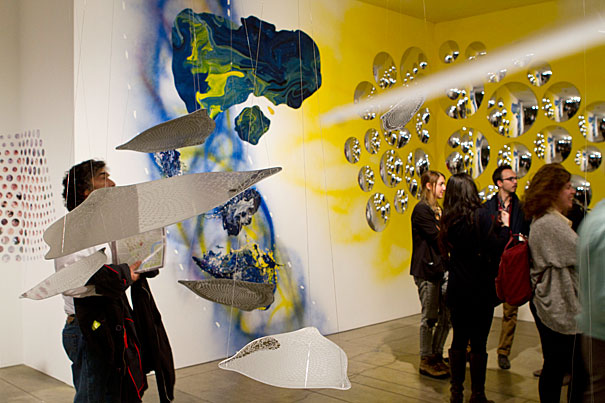
Lisa Randall, a Harvard theoretical physicist, curated the show with artist Lia Halloran, asking contributors to develop works that examined scale. The resulting exhibition features contemporary works that include a video installation, photography, and a social experiment involving cupcakes.
Photos by Meghan Dhaliwal/Harvard Staff Photographer
Scaling up, and down
Physicist, artists team up for offbeat Carpenter Center show
Breaking down heady scientific concepts is Lisa Randall’s specialty.
The Harvard theoretical physicist, an authority on both the study of the minute, such as the building blocks of matter, and the massive, like the makeup of the universe, has written works that help to demystify the worlds of cosmology and particle physics.
Now the dark-matter guru is illuminating science with art.
In “Measure for Measure” a new exhibition at Harvard’s Carpenter Center for the Visual Arts, Randall and eight Los Angeles-based artists dive into the artistic and scientific notion of scale.
The concept is central to the role of the Large Hadron Collider (LHC), a mammoth ring of superconducting magnets buried underground on the French-Swiss border, whose goal is to unlock secrets of the universe by smashing together subatomic particles. Much of Randall’s own theoretical work involves the LHC. She describes the giant machine’s relationship to scale in her recently published “Knocking on Heaven’s Door: How Physics and Scientific Thinking Illuminate the Universe and the Modern World.”

It was while Randall, the Frank B. Baird Jr. Professor of Science, was finishing her new book that the Los Angeles Art Association asked her to curate a show. Randall chose to develop the exhibition around the idea of scale, a subject much on her mind, and a vital concept for artists and scientists alike.
“The question is how do you get good art while thinking about real scientific themes,” said Randall. “The idea I had was to come up with a theme that would resonate with both artists and scientists. Of course, artists are thinking about scale all the time, and so are we.”
Randall curated the show with artist Lia Halloran, asking contributors to develop works that examined scale. The resulting exhibition features contemporary works that include a video installation, photography, and a social experiment involving cupcakes.
The show debuted at the Los Angeles association and then moved to the Guggenheim Gallery at Chapman University.
This isn’t Randall’s only foray into the art world. Two years ago she collaborated on her first opera with the Spanish composer Hector Parra, who asked her to write a libretto based on her theory of extra dimensions to the universe. The result, “Hypermusic Prologue: A Projective Opera in Seven Planes,” premiered at the Pompidou Center in Paris in 2009.
“I see art not so much as teaching science but maybe making people aware of scientific ideas and intricacies,” said Randall. “Within this new show, there are themes and ideas that are resonating and can really make people think more broadly about art and science.”
For David Rodowick, the show’s collaborative nature represents an important innovative direction for Harvard. “I am interested more and more in opening the Carpenter Center to collaborations with other parts of the University,” said Rodowick, who is director of the center and is the William R. Kenan Jr. Professor of Visual and Environmental Studies. “One of the things we should be doing at the Carpenter Center is framing art within broader dialogues.”
Each piece in the new exhibition engages viewers in dynamic, sometimes difficult ways.
Barbara Parmet’s work, “Redwood With Floating Pine Needles,” challenges the notion of scale with a dizzying photograph of a giant Redwood tree that extends from floor to ceiling.
Adding her clever twist on scale is the work of artist Susan Sironi, called “Actual Size: A Self Portrait in Four Parts.” Using classic tales that play with scale, like Lewis Carroll’s “Alice’s Adventures in Wonderland” and Jonathan Swift’s “Gulliver’s Travels” as her base, Sironi carved into the books tracings of her hand and foot, her profile, and a cross section of her neck.
Perhaps the most surprising take on the show’s theme is the work of Elizabeth Tobias, who explored the concept of economic scale. Over several months, Tobias hit the streets of Los Angeles, asking people to jot down on an index card their thoughts on hunger and poverty in return for a cupcake.
The result of her efforts, “The Cupcake Project,” is housed in a yellow emergency tent on the center’s first floor. The space is softly lit with pastel Chinese lanterns, from which hang those index cards. The gentle tone of the presentation is in sharp contrast to the hard message of the work. One card reads, “My sister is homeless and has a 9-year-old that does not get cupcakes even on her birthday.”
The show, on view through Dec. 22, is made possible with support from the Provostial Fund for Arts and Humanities at Harvard University.




